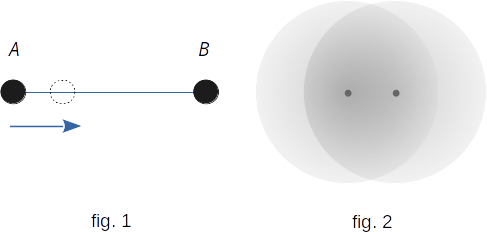From the Electrostatics
69. Electric field
Faraday's ideas.
A decisive turn to the ideas of proximity action was initiated by the great English scientist Michael Faraday - creator of the basic ideas of the theory of electromagnetism, and finally completed by Maxwell.According to the theory of action at a distance the one charge directly "feels" the presence of another. When one of the charges A (fig. 1) is moved, the force acting on the other charge B changes its value instantly. But neither with the charge B itself, nor with the space surrounding it, any changes occur.
According to Faraday's ideas, electric charges do not act on each other directly. Each of them creates an electric field in the surrounding space. The field of one charge acts on the other, and vice versa (fig. 2). The magnitude of the field decreases as it moves away from the charge.

Originally this idea expressed only Faraday's belief that the action of one body on another through the free space (void) is impossible. There was no proof that the field existed.
The velocity of electromagnetic interactions.
But after some time Maxwell managed to theoretically prove that electromagnetic interactions spread in space with finite speed.This means that if you move charge A slightly (fig. 1), the force acting on charge B will change, but not in the same moment, but only after time.
\( t ~= ~\frac{AB}{c} \) (8-8)
where AB is the distance between the charges, and \(c\) is the velocity of electromagnetic interactions. Maxwell found that it is equal to the speed of light in the free space, i.e. \(300,000 \,km/sec ~(3 \times 10^{10} \,centimetres \,(186,000 \,miles) \,per \,second)\). If charge A moves, the electric field around charge B will change after time \(t\).
This means that there is indeed a process between the charges in the free space, as a result of which the interaction between the charges spreads at a finite speed. What kind of process is that we will learn in Book Four. The presence of a certain process in space between interacting bodies, acting with finite time, is the main thing that distinguishes the theory of proximity from the theory of distance action. All other arguments in favor of this or that theory cannot be considered decisive. It is true that the experiment to check the equality \((8-8)\) in the movement of charges is difficult to implement because of the large quantity of velocity \(c\). But there is no need to do it now, after the invention of radio.
Radio waves.
Radio communication is communication through electromagnetic interactions, since a radio wave is an electromagnetic wave. Now you can just read in scientific journals that a radio wave comes from a space satellite approaching Venus for more than four minutes to Earth. The satellite can already burn in the atmosphere of the planet, and the radio waves it sends will wander for a long time in space until they are absorbed by the bodies. Thus, the electromagnetic field is now detecting itself as something as real as the table at which you sit.It is no longer possible to dismiss the idea of the field as something complex and vague, confusing simple things, as the supporters of action at a distance thought.
The idea that the body can act where it does not exist was disproved experimentally, even though at one time it seemed that the very development of science requires its recognition.
(According to modern concepts, gravity interactions also occur through a special field called a gravitational or attraction field. The gravitational field is created by masses of bodies and manifests itself by the action on masses. The gravitational interactions must also be spread at a speed of \( ~c \,= \,300,000 km/sec\). However, this has not been experimentally proven yet.)
What is an electric field?
But what does an electric field represent? We know that the electric field really exists. We can learn its properties experimentally. But we don't perceive it by any of our senses and, most importantly, we can't tell what the field is made of. Here we face the boundary of what's now known in science. The house is made up from bricks and slabs and other materials. They are formed by molecules and molecules by atoms. Atoms are made from elementary particles.Elementary particles... are not made up from anything simpler than themselves. At least we don't know any simpler formations now. It's the same with the electric field. Nothing simpler, more basic than a field, we don't know.
So the answer to the question of what an electric field is can only be that.
First, the field is material in the sense that it exists independently of us, from our knowledge of it.
Secondly, it has certain properties that do not allow it to be confused with anything else in the world around it. The list of these properties is the only answer to the question what an electric field is.
When we study the electric field, we are faced with a special form of matter, the motion of which is not subject to the laws of Newton's mechanics. With the discovery of the electric field for the first time in the history of science there was a deep idea: there are different types of matter, and each of them has its own laws.